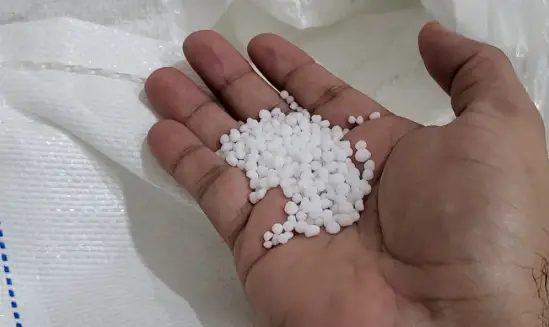
International fertilizer prices continue to adjust to align with the relative value of grains. While the trend is led by nitrogenous fertilizers, phosphate prices are also falling.
This week, the main focus in the urea market was on the possibility of India launching a new purchase tender, while doubts persist as to whether China will extend its export quotas beyond October 15, 2025.
In the US, according to the latest report from the consulting firm IF Ingeniería en Fertilizantes, shipments at New Orleans (NOLA) terminals closed the week with further declines, reaching US$388-400/ton FOB. Export prices also continued to fall in the Baltic, Egypt, and the Middle East. In Brazil, urea imports were recorded in a general range of US$420 to US$430/ton CFR.
The international phosphate market was characterized by weak demand, reflected in the lack of progress in key bidding processes in Asia and Africa.
“The postponement of processes in Bangladesh and Ethiopia left many players waiting, while India maintained stable prices but with high inventories limiting new purchases,” the report states.
“At the same time, Brazil consolidated a downward bias with little import interest and declining domestic prices. China maintained FOB values for DAP and MAP, although with declining exports,” it adds.
In the US, monoammonium phosphate (MAP) fell sharply, while diammonium phosphate remained more stable in a range of US$775 to US$780/ton FOB.
However, in Morocco, the OCP corporation completed sales of DAP and MAP to Europe at prices higher than the previous week.
In Brazil, CFR MAP purchases remained within a range of US$710 to US$730/ton, although the domestic market fell to the equivalent of US$650 to US$665/ton. August imports totaled 255,543 tons (down 55% year-on-year), accumulating 2.41 million tons in the first eight months of the year (down 17%).
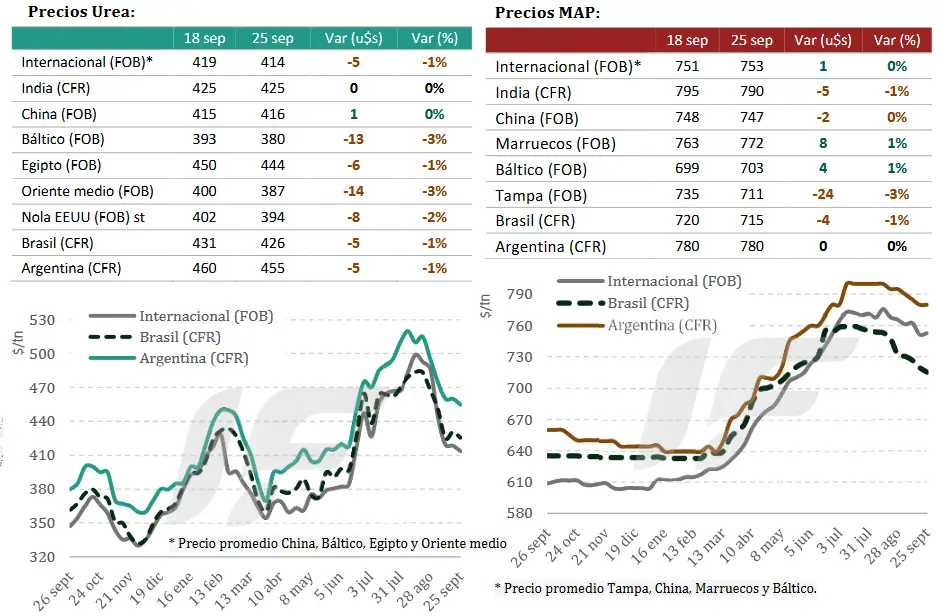
In the Argentine market, following the announcement of the suspension of export duties on the fertilizer sector, a surge in purchases was expected, but ultimately failed to materialize due to the unexpected end of the measure (which was only extended for three days).
In the Argentine market, “urea partially reflects international declines, although the product shortage associated with late purchases prevents the drop from being fully reflected in domestic prices.”
“In phosphates, most costs have already been assumed, so no additional declines are expected in the Argentine wholesale market beyond margin adjustments to stimulate sales,” it notes.
The consulting firm also highlighted that the availability of MAP 11-52 and DAP is limited, while offers of blends and MAP 10-50 are increasingly aggressive as companies attempt to clear inventories before the end of the year. “This opens up attractive pricing opportunities for these products, whose quality is adequate and whose evaluation must be based on the cost per unit of nutrient,” it emphasizes.
Regarding liquid fertilizers, they have not kept pace with the decline in urea, which makes them less competitive in terms of cost per unit of nutrient.
In Argentina, 35,000 tons of urea were purchased this week at a price of US$450/ton CFR. Meanwhile, the MAP CFR was at US$780/ton, with rumors of trading below that level. The DAP CFR remained at US$770–775/ton.
Source: Valor Soja
Sulfur prices rise by 90% in Brazilian ports
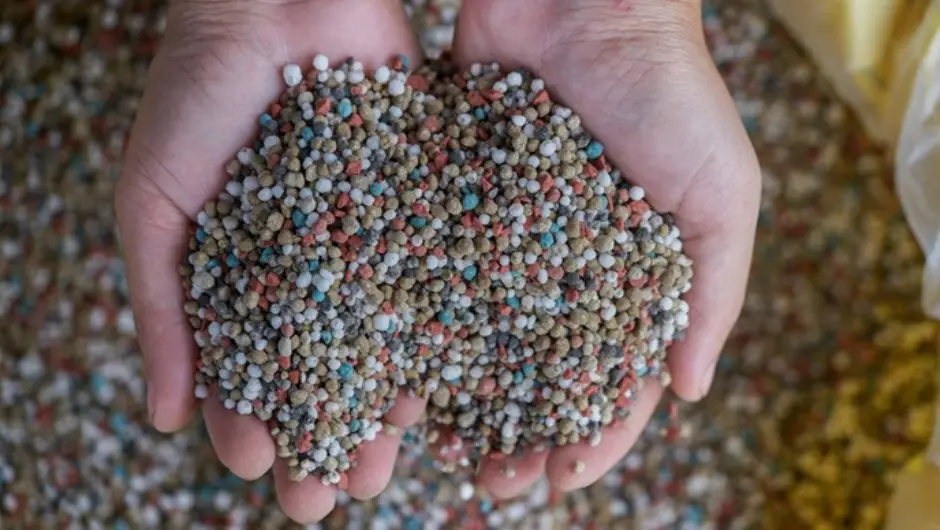
El aumento es una combinación de una demanda mundial elevada y una oferta restringida, lo que afecta a productores e importadores.
The increase is a combination of heated global demand and restricted supply, impacting producers and importers
The price of sulfur at Brazilian ports continues to rise, accumulating an increase of around 90% since the beginning of 2025, according to the weekly fertilizer report from StoneX, a global financial services company.
According to the survey, in the last week of September, the price recorded a weekly variation close to US$30, a rate of increase that intensified from the end of August. “This level has not been seen since 2022, when the war between Russia and Ukraine caused a surge in fertilizer prices,” highlighted Market Intelligence analyst Tomás Pernías.
This rise is a combination of strong demand and limited supply. As Pernías explains, countries like China and India continue to experience strong demand for the input, while global availability remains limited. “This scenario keeps prices high and could continue in the coming months,” he explained.
Sulfur is a strategic raw material for the production of sulfuric acid and phosphoric acid, used in phosphate fertilizers essential for Brazilian agriculture. Between January and August 2025, Brazil imported approximately 1,6 million tons of sulfur, an 8% increase compared to the same period in 2024.
This trend could impact fertilizer production costs: “The rise in sulfur prices, along with other inputs like ammonia, puts pressure on fertilizer costs. While this doesn’t always translate immediately into higher prices for farmers, the situation tends to reduce return margins, limit production, and generate market uncertainty,” Pernías emphasizes.
On the other hand, says the Market Intelligence analyst, these high costs also reduce companies’ propensity to cut prices. This is because, although rising sulfur prices alone don’t necessarily imply higher fertilizer prices, this trend isn’t favorable for importers or farmers.
“The outlook is challenging. In the 2025/26 harvest, both importers and farmers face high production costs, unattractive terms of trade, and an uncertain environment, with the risk of tariffs and sanctions on the fertilizer market,” he concludes.
Source: Cultivar Magazine

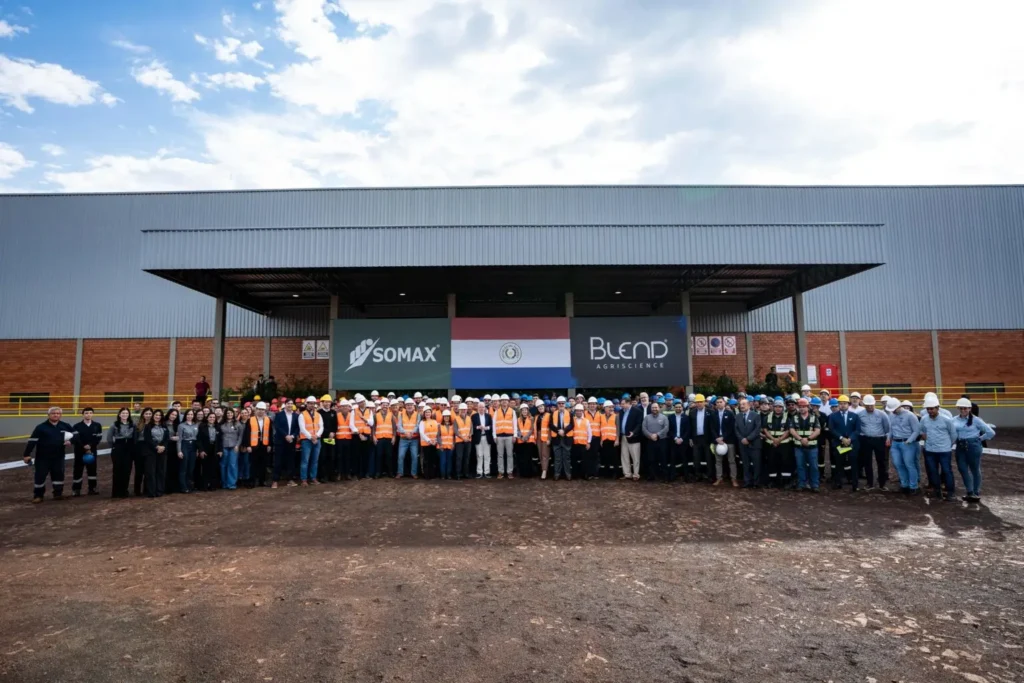
Fertilizer plant in Hernandarias aims to be the most modern in Latin America
Coinciding with National Industry Day, commemorated every September 8th, the President of the Republic visited the future Blend Agriscience Paraguay S.A. industrial plant in the city of Hernandarias, Alto Paraná department, where he praised the sector’s role in projecting a developed country.
The Somax Agro SA Group, responsible for promoting the future Blend Agriscience Paraguay S.A. industrial plant, is located in Paraguay’s main agricultural and productive areas, with more than 24 business units, nine branches, and 13 silos.
The company also operates in more than 10 strategic areas in Brazil. The headquarters are located in Hernandarias, as is its future agricultural production area. The president of the Somax Agro SA Group, Fabio Bedin, stated that they have more than 380 employees and the goal is to reach 500 employees once Blend is operational.
In this context, he emphasized that Blend is the group’s most ambitious project, under the slogan “create, innovate, and transform,” a pioneer in the implementation of continuous production processes. “We are in the final phase of this project. We purchased a 40-hectare area and are building a large-capacity industrial facility of more than 35,000 square meters, with the goal of producing more than 100 million liters per year in the initial phase. We will have more than 150 jobs in the initial phase,” he explained. The businessman mentioned that they aim to become the most modern industry in Latin America, hence the name Industry 4.0.
For his part, President Peña Nieto highlighted Paraguay’s rich land and fertility, which makes it a fundamental base for its agricultural export economy of products such as soybeans, corn, and beef. On this point, he emphasized that Paraguay continues to conquer markets and increase exports. However, he said that agricultural production is not enough to project a developed country; it requires a combination with industry to steer the nation’s growth. He also thanked the Somax Agro SA Group for once again investing in Paraguay, stating that having a new industry is a source of pride and celebration for Paraguayans.
The complex will feature four state-of-the-art laboratories and will be the first industry in the sector to obtain five international certifications. “With these advanced technologies, we can offer innovative solutions, reduce our environmental impact, and meet strict standards of quality, sustainability, and performance,” explained Arturo Elgue, Blend’s industrial director.
He noted that this project not only represents a technological breakthrough in innovation for Paraguay but will also have a significant impact on the regional economy. “This project is not just a factory; it’s the construction of a future for Paraguay, a future of innovation, security, and technological efficiency, which will contribute to the country’s development and the well-being of its people,” Elgue stated.
Source: ValorAgro
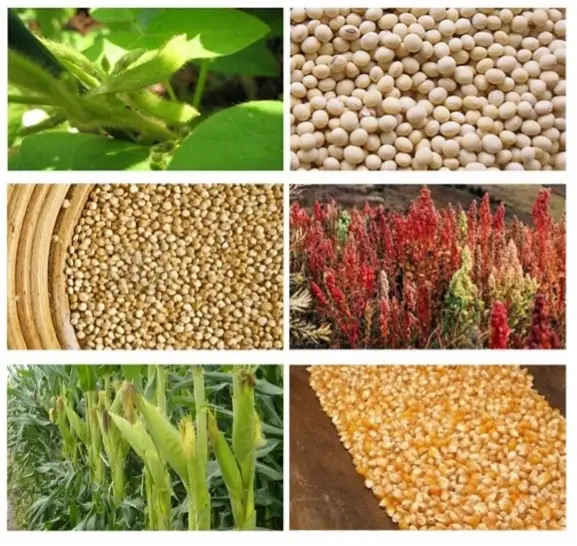
ARGENTINA MAIN CROPS OVERVIEW
CORN: Corn planting progressed satisfactorily, registering a week-over-week increase of 6.1 percentage points, reaching 12.3% of the total estimated for this season. In absolute terms, an estimated 1 million hectares have already been planted, compared to the 700,000 hectares planted at this point last year. While year-over-year progress has been recorded in much of the country, in some areas, excessive water levels persist, delaying planting plans and even shifting toward later plantings.
SUNFLOWER: Regarding sunflower planting, a week-over-week increase of 5.4 percentage points was recorded, reaching 31% of the projected area of 2.6 million hectares for the current cycle, registering advances of 22 and 12.9 percentage points compared to the previous cycle and the last five-year period, respectively. Following the recent rains, progress was made, allowing the completion of planting in the Northeast region and the resumption of work in north-central Santa Fe. However, collaborators assure that rainfall in the southern agricultural area will delay the start of the season. Regarding the standing area, 82.1% is in Adequate/Optimal water conditions, and 100% is in Normal to Excellent condition.
WHEAT: 70.9% of the estimated 6.7 MHa of wheat is progressing from stem elongation (tillering) onward. The recurrence of rainfall and accumulated volumes maintain 81.7% of the area in Adequate/Optimal water conditions. This availability of moisture is particularly favorable, especially in the central and northern agricultural area, where yield expectations continue to rise above average. Despite increasing reports of new outbreaks of fungal diseases, 96.9% of the cereal crop currently has Normal to Excellent crop condition. However, excessive rainfall in western and central Buenos Aires could disrupt the progress of refertilization and fungicide applications, impacting crop health.

